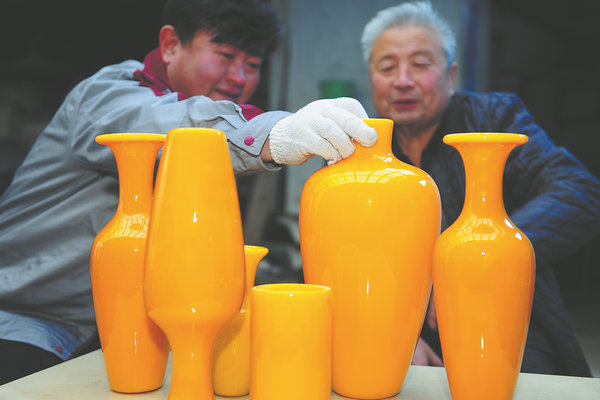

There was no surviving documentation of the full formula and composition of jiyouhuang, and each ingredient required research and experimentation.
"The formula we found generally mentioned white materials, such as aluminum oxide and quartz, but there was no hint of how much of each was needed. It also mentioned gray-colored substances like arsenic, but again, the exact composition and the precise amount of each component were not specified," he says.
Initially, the success rate was low.
"Nine out of 10 attempts were usually failures," Sun says. "Factors such as the quality of the raw materials, the control of the firing temperature, and even the climate, can significantly affect the final quality."
As if under a spell, he burned through the family savings and eventually filled in the missing information after years of endeavor.
He explored the use of other raw materials to improve the recipe, and upgraded both craftsmanship and techniques accordingly to refine the formula for jiyouhuang, giving rise to a much higher success rate and purity of product.
To ensure that only the finest pieces are created, Sun follows strict standards: if there are any bubbles or deviations in color, the product in question is immediately discarded.
According to evaluation by the Palace Museum in Beijing, his jiyouhuang pieces surpass the Qing Dynasty originals in quality.
In 2013, Sun became a national patent holder for the jiyouhuang production method, and the craft was named a provincial intangible cultural heritage in Shandong in 2016.
Many of his pieces have made their way to collectors, including in the United Kingdom, Australia and the United States.
Wang Feng, who switched to liuli design and sculpting in 2012 after being stunned by Sun's work, is now his apprentice.
"The jiyouhuang pieces are just extraordinary, and I can sense the rise in popularity of liuli over the years," says Wang, who is in his 40s.
He apprenticed with Sun in 2018, when he started to add creative touches to the natural patterns of his pieces.
"His friendliness toward people around him, patience in answering technical questions, and rigorous control of quality are nothing if not impressive," Wang says.
In addition to continuing to upgrade production and quality, Sun has paid equal attention to keeping up with market trends.
He believes that the art of liuli must explore new uses and contexts to broaden its appeal.
"We are constantly influenced by market demands and the aesthetic preferences of buyers to explore new possibilities, such as jewelry and cultural creative products. This way, we can integrate this national treasure into the daily lives of countless households," he says.